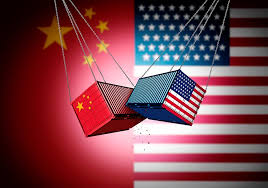
China’s top envoy to the United States invoked the ancient yin‑yang philosophy to recast bilateral ties as a delicate equilibrium rather than a direct showdown. He urged both nations to view their economic relationship as mutually reinforcing forces—complementary rather than adversarial.
By framing the U.S. and China as two halves of a greater whole, he signaled a willingness to find creative, win‑win solutions. Yet this olive‑branch rhetoric was laced with a warning: any overly aggressive move could tip the balance toward conflict.
Echoes of Smoot‑Hawley’s Legacy
Warning that history could repeat itself, the envoy likened current triple‑digit levies to the Smoot‑Hawley tariffs of 1930, which deepened the Great Depression. He cautioned that similarly punitive duties today risk triggering a global downturn of comparable severity.
This comparison served as both a historical lesson and a stark deterrent: unjustified tariffs do not safeguard domestic industries but instead contract world trade, corrode confidence, and invite economic hardship.
China has already slapped 125% duties on American goods, and officials made clear they stand ready to impose fresh counter‑tariffs at a moment’s notice. Even as conciliatory language dominated public forums, the subtext was unequivocal: Beijing will not absorb further U.S. levies without striking back.
This posture of measured yet firm readiness illustrates Beijing’s dual strategy—projecting peace on the surface while girding for escalation underneath. It underscores a simple truth: tariff hikes today almost guarantee fresh rounds of reprisals tomorrow.
Commerce on Ice
With duties now exceeding 100% in each direction, U.S.–China trade is effectively frozen. Containers that once moved smoothly between Pacific ports now gather dust, while services contracts and investment deals hang in limbo.
This gridlock has thrown established supply chains into disarray: manufacturers, shippers and investors find forecasting nearly impossible amid such policy whiplash. The stasis inflicts real costs, from idle factories to stalled construction projects and lost market opportunities.
Behind the envoy’s measured tones, China’s trade apparatus has shifted into a so‑called “wartime footing.” Senior bureaucrats in commerce and foreign affairs have canceled leave, remain on call around the clock, and coordinate daily crisis briefings.
This combative mobilization sits alongside the call for harmonious coexistence, illustrating a state prepared for both dialogue and defense. Such duality marks a strategic pivot away from purely diplomatic overtures toward an all‑of‑government readiness to counteract U.S. measures.
Port Fees Spark Maritime Battle
What began as a dispute over goods has spilled into logistics: China’s shipbuilders condemned proposed U.S. port‑fee plans as “short‑sighted,” warning that extra docking charges will drive up global shipping costs.
By dragging maritime fees into the tariff fight, the conflict threatens to ripple through international logistics networks. Dock operators, freight forwarders and cargo insurers now face new uncertainties on top of shuttered trade lanes.
While Washington touts a unified front, key U.S. trading partners have quietly sought exemptions. Japan is negotiating carve‑outs for automotive and electronics components, and Taiwan is pushing for relief on semiconductor exports.
These bilateral deals expose fractures in the coalition against China, as allies balance geostrategic solidarity with the imperative to protect vital industries at home. The result is a patchwork of carve‑outs that further complicates global trade rules.
“Private” Talks Under Preconditions
Despite public threats, Washington maintains it is holding “private” discussions with Beijing. Yet Chinese officials insist any formal negotiations must begin on a foundation of mutual respect—and a rollback of aggressive U.S. tariffs.
This insistence sets a high bar for reopening dialogue. In practice, it means that while low‑level channels remain active, substantive engagement is stalled until both sides signal genuine readiness to de‑escalate.
In a calculated move, Beijing recently installed a veteran WTO envoy as its lead trade negotiator. This signals a shift toward a rules‑based battle, with China preparing formal dispute challenges against U.S. levies.
By engaging the WTO’s dispute‑settlement machinery, China aims to frame the conflict as one over legal norms rather than raw power. Yet this procedural route can entangle cases in multi‑year proceedings, prolonging uncertainty.
Multinationals are racing to redesign their supply chains. Electronics giants are boosting production in Vietnam and Mexico, automakers are expanding plants in Southeast Asia, and pharmaceutical firms are diversifying active‑ingredient sourcing across India and Europe.
These shifts reflect an urgent need to hedge against tariff volatility. Companies that once concentrated sourcing in one country now adopt a “China + X” model, distributing operations to avoid being caught on the wrong side of sudden duties.
Accelerated Drive for Self‑Reliance
The tariff deadlock has also invigorated Beijing’s push for domestic champions. From semiconductors to shipbuilding, officials are funneling subsidies and fast‑tracking research to reduce reliance on foreign technology and inputs. High‑profile initiatives under the “Made in China” banner now target rapid gains in chip fabrication capacity and advanced materials. The goal: to blunt the impact of external pressure by building world‑class alternatives at home.
Both sides are gearing up for a cascade of WTO litigation over the legality of their unilateral tariffs and port‑fee schemes. Beijing intends to challenge U.S. levies as breaches of trade agreements, while Washington could retaliate through counter‑claims. Such legal jousts, however, offer only limited relief; rulings are slow, enforcement is often weak, and outcomes rarely satisfy either party fully. Instead, they serve as a theatrical backdrop to the more immediate struggle over economic power.
Beyond tariffs, the standoff is deepening a wider decoupling trend. Technology‑transfer restrictions, tightened investment rules and visa curbs now threaten cross‑border collaboration in research and education. Universities, start‑ups and joint ventures face new barriers, while expatriate communities and student exchanges contract. The widening cleft in people‑to‑people ties may prove the most enduring legacy of this conflict, reshaping the global order long after the last tariff is removed.
As China’s envoy extols the virtues of yin‑yang harmony, the underlying reality is far more combative. Tariff tit‑for‑tat, diplomatic militarization and legal entanglements now define U.S.–China economic relations. Whether balance can indeed be restored—or whether this confrontation accelerates a lasting split—remains the defining question of the era.
(Source:www.business-standard.com)
By framing the U.S. and China as two halves of a greater whole, he signaled a willingness to find creative, win‑win solutions. Yet this olive‑branch rhetoric was laced with a warning: any overly aggressive move could tip the balance toward conflict.
Echoes of Smoot‑Hawley’s Legacy
Warning that history could repeat itself, the envoy likened current triple‑digit levies to the Smoot‑Hawley tariffs of 1930, which deepened the Great Depression. He cautioned that similarly punitive duties today risk triggering a global downturn of comparable severity.
This comparison served as both a historical lesson and a stark deterrent: unjustified tariffs do not safeguard domestic industries but instead contract world trade, corrode confidence, and invite economic hardship.
China has already slapped 125% duties on American goods, and officials made clear they stand ready to impose fresh counter‑tariffs at a moment’s notice. Even as conciliatory language dominated public forums, the subtext was unequivocal: Beijing will not absorb further U.S. levies without striking back.
This posture of measured yet firm readiness illustrates Beijing’s dual strategy—projecting peace on the surface while girding for escalation underneath. It underscores a simple truth: tariff hikes today almost guarantee fresh rounds of reprisals tomorrow.
Commerce on Ice
With duties now exceeding 100% in each direction, U.S.–China trade is effectively frozen. Containers that once moved smoothly between Pacific ports now gather dust, while services contracts and investment deals hang in limbo.
This gridlock has thrown established supply chains into disarray: manufacturers, shippers and investors find forecasting nearly impossible amid such policy whiplash. The stasis inflicts real costs, from idle factories to stalled construction projects and lost market opportunities.
Behind the envoy’s measured tones, China’s trade apparatus has shifted into a so‑called “wartime footing.” Senior bureaucrats in commerce and foreign affairs have canceled leave, remain on call around the clock, and coordinate daily crisis briefings.
This combative mobilization sits alongside the call for harmonious coexistence, illustrating a state prepared for both dialogue and defense. Such duality marks a strategic pivot away from purely diplomatic overtures toward an all‑of‑government readiness to counteract U.S. measures.
Port Fees Spark Maritime Battle
What began as a dispute over goods has spilled into logistics: China’s shipbuilders condemned proposed U.S. port‑fee plans as “short‑sighted,” warning that extra docking charges will drive up global shipping costs.
By dragging maritime fees into the tariff fight, the conflict threatens to ripple through international logistics networks. Dock operators, freight forwarders and cargo insurers now face new uncertainties on top of shuttered trade lanes.
While Washington touts a unified front, key U.S. trading partners have quietly sought exemptions. Japan is negotiating carve‑outs for automotive and electronics components, and Taiwan is pushing for relief on semiconductor exports.
These bilateral deals expose fractures in the coalition against China, as allies balance geostrategic solidarity with the imperative to protect vital industries at home. The result is a patchwork of carve‑outs that further complicates global trade rules.
“Private” Talks Under Preconditions
Despite public threats, Washington maintains it is holding “private” discussions with Beijing. Yet Chinese officials insist any formal negotiations must begin on a foundation of mutual respect—and a rollback of aggressive U.S. tariffs.
This insistence sets a high bar for reopening dialogue. In practice, it means that while low‑level channels remain active, substantive engagement is stalled until both sides signal genuine readiness to de‑escalate.
In a calculated move, Beijing recently installed a veteran WTO envoy as its lead trade negotiator. This signals a shift toward a rules‑based battle, with China preparing formal dispute challenges against U.S. levies.
By engaging the WTO’s dispute‑settlement machinery, China aims to frame the conflict as one over legal norms rather than raw power. Yet this procedural route can entangle cases in multi‑year proceedings, prolonging uncertainty.
Multinationals are racing to redesign their supply chains. Electronics giants are boosting production in Vietnam and Mexico, automakers are expanding plants in Southeast Asia, and pharmaceutical firms are diversifying active‑ingredient sourcing across India and Europe.
These shifts reflect an urgent need to hedge against tariff volatility. Companies that once concentrated sourcing in one country now adopt a “China + X” model, distributing operations to avoid being caught on the wrong side of sudden duties.
Accelerated Drive for Self‑Reliance
The tariff deadlock has also invigorated Beijing’s push for domestic champions. From semiconductors to shipbuilding, officials are funneling subsidies and fast‑tracking research to reduce reliance on foreign technology and inputs. High‑profile initiatives under the “Made in China” banner now target rapid gains in chip fabrication capacity and advanced materials. The goal: to blunt the impact of external pressure by building world‑class alternatives at home.
Both sides are gearing up for a cascade of WTO litigation over the legality of their unilateral tariffs and port‑fee schemes. Beijing intends to challenge U.S. levies as breaches of trade agreements, while Washington could retaliate through counter‑claims. Such legal jousts, however, offer only limited relief; rulings are slow, enforcement is often weak, and outcomes rarely satisfy either party fully. Instead, they serve as a theatrical backdrop to the more immediate struggle over economic power.
Beyond tariffs, the standoff is deepening a wider decoupling trend. Technology‑transfer restrictions, tightened investment rules and visa curbs now threaten cross‑border collaboration in research and education. Universities, start‑ups and joint ventures face new barriers, while expatriate communities and student exchanges contract. The widening cleft in people‑to‑people ties may prove the most enduring legacy of this conflict, reshaping the global order long after the last tariff is removed.
As China’s envoy extols the virtues of yin‑yang harmony, the underlying reality is far more combative. Tariff tit‑for‑tat, diplomatic militarization and legal entanglements now define U.S.–China economic relations. Whether balance can indeed be restored—or whether this confrontation accelerates a lasting split—remains the defining question of the era.
(Source:www.business-standard.com)





